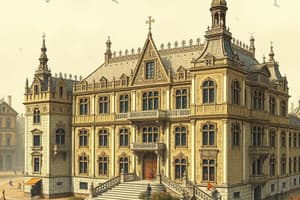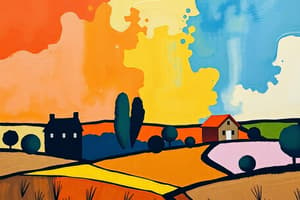Podcast
Questions and Answers
What was the role of the seneschal in a manor?
What was the role of the seneschal in a manor?
- To ensure peasants worked hard in the fields
- To manage the noble's fiefs by visiting each regularly (correct)
- To live in a castle
- To give out fines and punishments
Every manor had a court of law that settled disputes and discussed manor business.
Every manor had a court of law that settled disputes and discussed manor business.
True (A)
What types of food did the men and women of the manor produce?
What types of food did the men and women of the manor produce?
Food, clothing, and shelter, including grain, vegetables, meat, milk, and wool.
The cottages in the village were mostly made of __________ and earth.
The cottages in the village were mostly made of __________ and earth.
Match the following roles with their responsibilities:
Match the following roles with their responsibilities:
What was the primary duty of a vassal?
What was the primary duty of a vassal?
All nobles were ultimately vassals of the king.
All nobles were ultimately vassals of the king.
What was given to a vassal to show that the lord's word could be trusted?
What was given to a vassal to show that the lord's word could be trusted?
A vassal's fief typically passed on to his oldest ________ when he died.
A vassal's fief typically passed on to his oldest ________ when he died.
Match the following roles with their descriptions:
Match the following roles with their descriptions:
What ceremony formally established the tie between a lord and a vassal?
What ceremony formally established the tie between a lord and a vassal?
Vassals were required to provide food and entertainment when their lord visited.
Vassals were required to provide food and entertainment when their lord visited.
How many days a year were vassals expected to perform military service?
How many days a year were vassals expected to perform military service?
What was the primary basis of power during feudal times?
What was the primary basis of power during feudal times?
Kings had full control over land ownership before feudalism was established.
Kings had full control over land ownership before feudalism was established.
Who began the practice of giving fiefs to soldiers in exchange for loyalty?
Who began the practice of giving fiefs to soldiers in exchange for loyalty?
After Charlemagne’s death in 814, Europe had no ____ government.
After Charlemagne’s death in 814, Europe had no ____ government.
What role did nobles take on by 900 in regards to their lands?
What role did nobles take on by 900 in regards to their lands?
Match the following roles with their corresponding responsibilities in the feudal system:
Match the following roles with their corresponding responsibilities in the feudal system:
Peasants had equal rights to participate in the government as the clergy and nobles.
Peasants had equal rights to participate in the government as the clergy and nobles.
What did peasants give in return for protection from nobles?
What did peasants give in return for protection from nobles?
Flashcards
Feudalism
Feudalism
A system of land ownership and social hierarchy that dominated Europe during the Middle Ages.
Fiefs
Fiefs
Estates granted by rulers to soldiers in exchange for their service.
Military Service in exchange for Land
Military Service in exchange for Land
The practice of rewarding military service with land ownership, which became common in Europe after Charlemagne's death.
Post-Charlemagne Europe
Post-Charlemagne Europe
Signup and view all the flashcards
Emergence of Feudal Territories
Emergence of Feudal Territories
Signup and view all the flashcards
Peasants
Peasants
Signup and view all the flashcards
Peasant Obligations
Peasant Obligations
Signup and view all the flashcards
Feudal Authority
Feudal Authority
Signup and view all the flashcards
Seneschal
Seneschal
Signup and view all the flashcards
Bailiff
Bailiff
Signup and view all the flashcards
Manor Court
Manor Court
Signup and view all the flashcards
Noble's Residence
Noble's Residence
Signup and view all the flashcards
Lord and Vassal
Lord and Vassal
Signup and view all the flashcards
Act of Homage
Act of Homage
Signup and view all the flashcards
Ransom
Ransom
Signup and view all the flashcards
Military Service
Military Service
Signup and view all the flashcards
Manor
Manor
Signup and view all the flashcards
Officials
Officials
Signup and view all the flashcards
Study Notes
Feudal System
- Power based on land ownership, Kings initially owned all land, Charles Martel distributed land (fiefs) for loyalty and service
- Land ownership tied to military service, Power and wealth came with land, Example followed by European Kings after Martel's example
- Rise of Feudal Territories, Weak Kings after Charlemagne's death, Could not control kingdoms, Needed nobles for resources
- Nobles gained power and independence, Collected taxes, Enforced laws in their areas, Built armies, and minted their own coins
- Nobles Protected Lands and People, Protected peasants from Vikings by building fortresses, peasants gave land and freedom in return for protection
- Feudal Territories, Divided Western Europe into small territories in 1000 AD, Similar size to ancient Greek city-states, Noble controlled the areas politically
- NO Central City, Unlike Greek polis (city-states), Nobles held political power
- Peasant status, Peasants had little to no political power, Believed God wanted the hierarchy as it was, Few people challenged the system
- Lord and Vassal, Loyalty and Duty among nobles, Vassal served a higher-ranking noble (lord), Vassal received protection in return
- Act of Homage, Ceremony, Vassal knelt before lord, pledged loyalty, lord accepted the pledge, a symbolic gesture of trust,
Lord and Vassal Relationship
- Vassal Service, Loyalty, Vassals had to support lord in battle, 40-60 days of military service per year
- Vassal Payments, Vassals gave money for lord's events (e.g., daughter's marriage, son becoming knight), Ransomed lords if captured
- Vassal Duties, At tended lord's court, Provided food and entertainment, If a vassal failed, lord could take the fief/land
- Succession, When vassal died, the fief usually went to oldest son, Important aspects of Feudalism
Manor Life
- Dependence on Land, Nobles, Knights, and peasants relied on land for resources and survival
- Manor System, Farming communities (Manors) were located on fiefs, owned by nobles
- Manor Officials, Nobles chose officials to manage manors (e.g., seneschal, bailiff), Ensured orders were followed and the needs of the noble were fulfilled. This included law courts to resolve conflicts
- Daily Life, Isolated manor life, Villages were self-sufficient in food, clothing, and shelter, Produced their own food, livestock, cloth, and tools. There was very little trade between manors
- Village Structure,Cottages clustered around a green space(village green), Made of wood and earth, Usually only one room
- Living Conditions, Simple and crowded living conditions, Poor sanitation, Diseases, and fleas widespread, Very limited furniture (3-legged stools and tables), slept on piles of straw or dirt
Studying That Suits You
Use AI to generate personalized quizzes and flashcards to suit your learning preferences.




